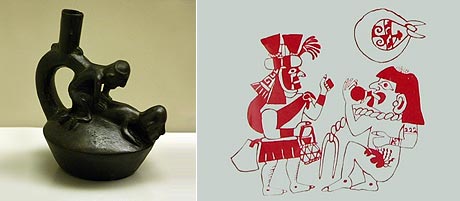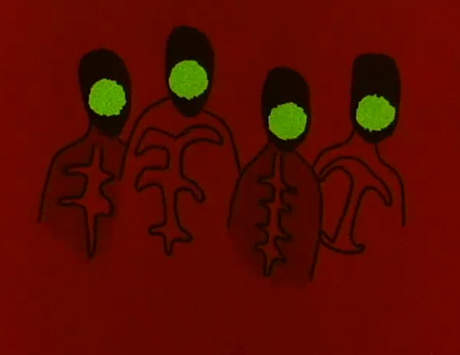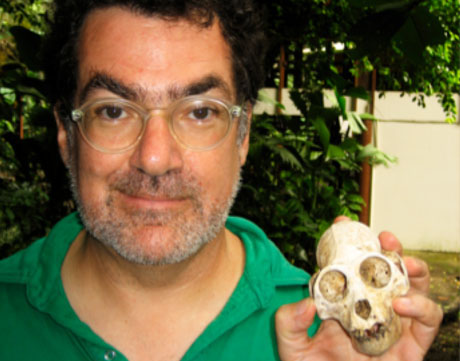Still from Moschops, 2000
IB: The universe of your films is dangerous, containing the perverse, the transgressive. What kind of audience reactions do you get?
JT: People tend to be polite during my movies but, to me, all of them are funny and I like when people laugh. My humor makes people a little nervous and I get nervous myself when the audience is overly respectful. I prefer giggling and snickering. It's a compliment to say my films are perverse or transgressive; I tend to think of them as humorously repressed and uptight.
Download Video:
MP4,
Ogg
HTML5 Video Player by VideoJS
Excerpt from Jim Trainor's Harmony, 2004, (0:52), TRT: 12:00
Given that your work elicits squirming, have you had this experience yourself looking at films? What about Un Chien Andalou?
I always cover my eyes during that eyeball scene. Basically, I can dish it out but I can't take it!
Interesting how your work contains the cruel and the tender.
I would like to explore my tender side more, but keep on getting seduced into further exploring my cruel side. Let’s see if I curb it after I get this parasitic wasp project over with. I do have a couple of entirely good-natured and sentimental projects in mind.
"I don't want to make a movie that just kind of luridly makes fun of grotesque customs in other cultures," you've said. Yet you do look from the outside at 'other' practices as 'strange.'
My films Harmony and The Presentation Theme teeter, I admit, uncomfortably close to the no-no of unflatteringly representing human cultures other than our own. Of course I am against intolerance, ethnocentrism, arrogance and superiority. But I am also horrified, stunned, confused and depressed by the imagery in Moche pottery. I can hide behind the fact that it's a long extinct culture, with no one to be offended by my representation. But I can feel people squirming a bit when they watch it.
What first fascinated you about Moche art?
It’s very varied and complex. Two major themes especially intrigue me. One is human sacrifice. The fine-line paintings, as they are called, which appear on pottery, show horrible torture scenes; these images were reiterated for centuries. Sex is the other theme that interests me.

Vessel c: 900AD [1]
Moche rites [2]
There are hundreds of Moche erotic pottery objects and, at a glance they suggest a society liberated about sex, but on closer examination all of the erotic imagery appears to be part of a priestly ritual, some kind of death-laden mirror image to procreative sex, which is almost never depicted in the art. By the way, I didn't copy the look of Moche art in my film, just the themes and ideas.
Despite the darkness of some of my films that draw on other cultures, in fact, my worldview is quite generous towards humanity. I admit that I’m morbidly attracted to ugly branches of human history such as the idea of tribal dystopia: small-scale societies coming up with unspeakable solutions to human problems. It makes sense that people, in their endless creativity, turn violence into pageantry and art. The baroque ornamentation of skulls, and their spectacular display, across many cultures and centuries, fascinates me.
If I were an anthropologist, or a scientist of any sort, I’d probably be too timid to indulge these attractions, but as an artist I'm off the hook. To reiterate what I said earlier, I am more interested in moral confusion than certitude. Having tried to understand any number of things without much success, I think it's okay that my films reflect my moral and philosophical confusion.

Still from Harmony, 2004
An interviewer once called Joan Didion's work apotropaic, as if writing about the deadly, the catatonic, the shadow, was an attempt to ward it off in life. Could it be that your body of work is also apotropaic?
Now, that's a good guess that I would engage in morbid subjects as a way to ward off destruction. Actually, I have encountered that terrific word, in archaeological contexts. In Mesopotamia they buried big-eyed figurines in tombs as if to keep someone on the lookout during the afterlife. Ah, but I wouldn't be a good atheist if I actually believed in magic. In any case I don't expect to be devoured by an internal parasite, so maybe it's working!

Jim Trainor